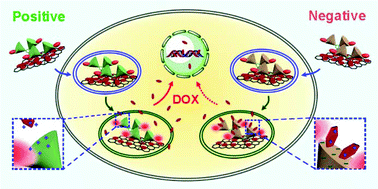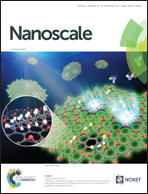Functionalized graphene sheets for intracellular controlled release of therapeutic agents†
Abstract
Since therapeutic agents target specific compartments inside the cells, their efficiency depends on their intracellular release from drug delivery systems (DDS). However, control over the intracellular release of therapeutic agents is a challenging issue and can only be achieved by governing their interactions with the DDS. In this work, polyglycerol amine- and polyglycerol sulfate-functionalized graphene sheets as positively and negatively charged 2D nanomaterials with 150 nm lateral size were used to deliver and control the release of doxorubicin (DOX) inside cells. A pH-sensitive dye was conjugated onto the surfaces of graphene sheets and used as an antenna to obtain specific signals from the acidic cell compartments. It was found that both positively and negatively charged graphene sheets undergo similar acidification processes after cellular uptake. Nevertheless, the intracellular drug release of these DOX-loaded nanomaterials was distinctly different. As an overall effect of the π–π stacking and electrostatic interactions, the release of DOX from the positively charged graphene sheets was much faster than that from their analogs with a negative surface charge. Therefore, therapeutic efficiency in the first case was much higher than that in the latter. Based on our findings, the intracellular release of drugs from the surfaces of graphene sheets can be finely tuned by manipulating their functionalities, which is of great importance in the designing of the future graphene-based nanomedicines.

- This article is part of the themed collection: Graphene Turns 15: Bio-implications and Bio-applications


 Please wait while we load your content...
Please wait while we load your content...